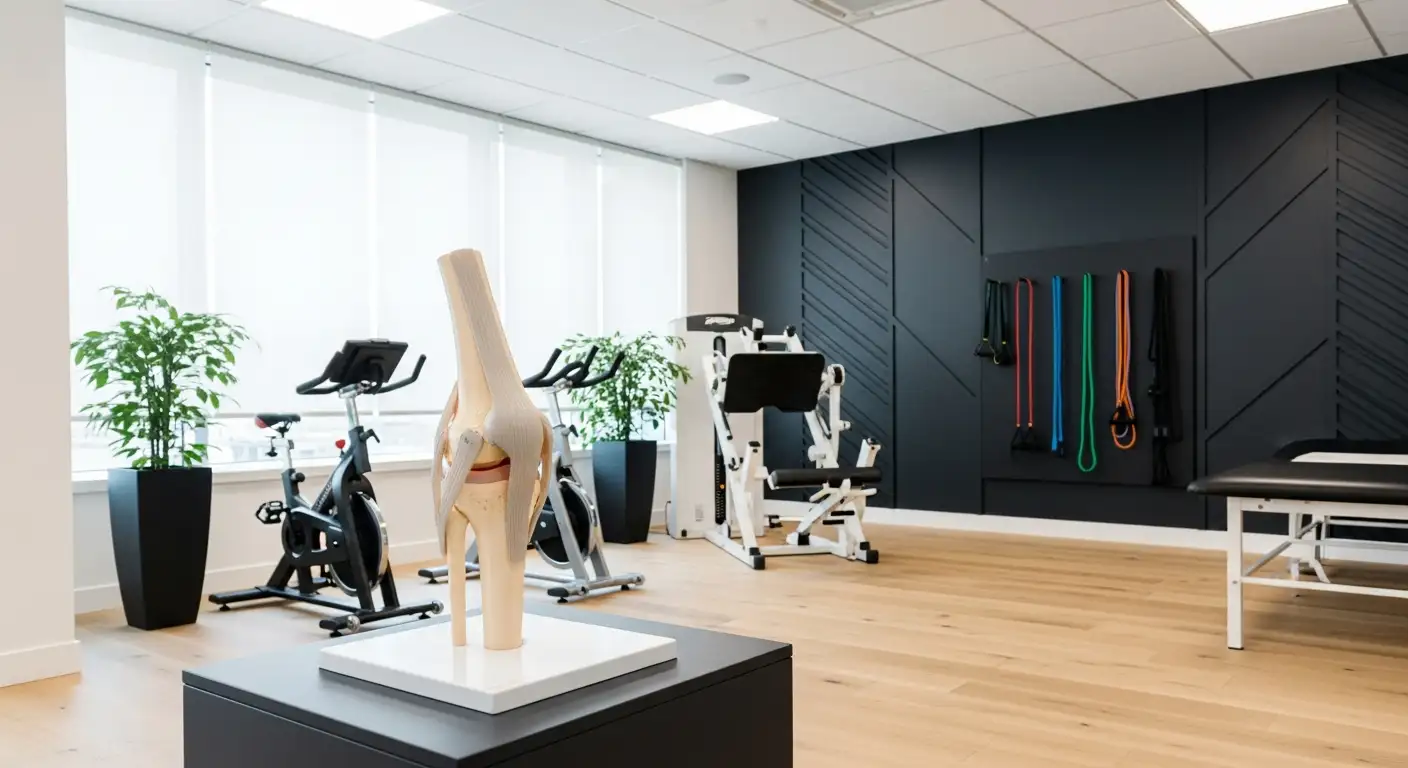Understanding Quadriceps Tendon Pain
Quadriceps tendon pain can be a common ailment, especially among those involved in sports and physical activities. This pain often arises due to a condition known as quadriceps tendonitis.
Defining Quadriceps Tendonitis
Quadriceps tendonitis is a condition characterized by inflammation and pain in the quadriceps tendon, which is located at the base of the quadriceps muscle, just above the kneecap. This condition is most commonly caused by overuse, especially in athletes who participate in sports that require jumping and running, such as basketball and soccer [1]. Quadriceps tendon pain can also result from tendon overload due to repetitive overloading, poor movement patterns, or changes to training routines, among other factors.

Symptoms of Quadriceps Tendonitis
The most common symptom of quadriceps tendonitis is pain and tenderness at the base of the quadriceps muscle, above the kneecap. This pain can often limit a person's ability to perform daily activities and sports, and is known to occur more frequently in sports that involve repetitive jumping or kicking, such as basketball, soccer, or volleyball.
Other notable symptoms may include:
- Pain that worsens with activity and improves with rest
- Swelling and inflammation around the affected area
- A sensation of warmth or burning in the affected area
- Difficulty in bending or straightening the knee
Understanding the symptoms and causes of quadriceps tendon pain can pave the way for effective treatment and management of this condition. It's important to consult with a healthcare provider for a proper diagnosis and personalized treatment plan if you're experiencing persistent or severe symptoms associated with quadriceps tendonitis.
Causes of Quadriceps Tendon Pain
Understanding the causes of quadriceps tendon pain is crucial for effective treatment and prevention. The pain is often a result of certain lifestyle factors, particularly those related to physical activity and sports.
Role of Overuse and Activity Levels
One of the primary causes of quadriceps tendon pain is overuse of the tendon, typically due to repetitive movements or activities. This overuse can lead to tendon overload, which can cause pain, inflammation, and even injury. Factors contributing to this overload may include repetitive overloading, poor movement patterns, or changes to training routines, among other factors.
When the activities causing the overload are not adjusted or moderated, the constant stress on the tendon can lead to quadriceps tendonitis, a condition characterized by pain, swelling, and inflammation of the tendon.
Impact of Sports and Exercise
Certain sports and exercises can significantly contribute to the development of quadriceps tendon pain. Sports that involve repetitive jumping or kicking, such as basketball, soccer, or volleyball, are known to cause more frequent cases of this condition [2].
The repetitive movements involved in these sports can put a lot of stress on the quadriceps tendon, leading to overuse and overload. This is particularly the case in sports that require a lot of running and jumping, as these activities put a significant amount of strain on the quadriceps tendon.
Understanding these causes of quadriceps tendon pain can help individuals make informed decisions about their activity levels and exercise routines. With proper management and care, it's possible to participate in these activities while minimizing the risk of quadriceps tendon pain.
Diagnosing Quadriceps Tendon Pain
Proper diagnosis of quadriceps tendon pain is imperative to ensure the correct treatment and recovery plan. This involves a series of clinical evaluations and tests to accurately pinpoint the source of the pain.
Clinical Evaluation and Tests
A thorough clinical evaluation is crucial for the diagnosis of quadriceps tendon pain. This evaluation typically includes a detailed medical history, a physical examination, and possibly imaging studies such as ultrasound or MRI. These imaging tests provide visual evidence of the condition, confirm the diagnosis, and rule out other potential causes of knee pain.
In a physical examination, the physician will typically palpate (touch) the affected area to identify any swelling or tenderness, and assess the patient's range of motion and strength. They may also ask the patient to bend and straighten their knee, or perform specific movements to determine the severity of the discomfort.
Distinguishing Quadriceps Tendonitis
While diagnosing quadriceps tendon pain, it's crucial to distinguish quadriceps tendonitis from other conditions that may produce similar symptoms. Symptoms of quadriceps tendonitis typically include anterior knee pain, most commonly located at the origin of the patellar tendon (65% to 70% of cases), followed by the insertion of the quadriceps tendon at the superior pole of the patella (20% to 25%), and the patellar tendon insertion on the tibial tuberosity (5% to 10%). These symptoms are often exacerbated by physical activity and relieved by rest.
However, the diagnosis of quadriceps tendonitis is not solely based on symptoms. There are classification systems proposed by Blazina et al., Roels et al., and Ferretti et al., based on the effects of pain and sports performance, and the intensity of pain. Currently, there is no universally accepted classification system for quadriceps tendinopathy based on pathologic tendon features rather than solely symptoms. Further studies are needed to develop a classification scheme that can assist in the management of tendinopathy in clinical practice.
In the meantime, a thorough clinical evaluation coupled with imaging tests remains the most effective approach to diagnosing quadriceps tendon pain. Once a diagnosis is confirmed, an appropriate treatment plan can be put in place to alleviate symptoms and promote recovery.
Treating Quadriceps Tendon Pain
When it comes to addressing quadriceps tendon pain, the approach can range from non-operative methods to surgical intervention, depending on the severity and persistence of the condition.
Non-operative Treatment Methods
The initial treatment for quadriceps tendon pain focuses on reducing pain and inflammation. This typically involves rest, ice, compression, and elevation, commonly known as the RICE protocol. At the same time, nonsteroidal anti-inflammatory drugs (NSAIDs) may be used to help manage the pain and inflammation.
Physical therapy plays a crucial role in the non-operative treatment of quadriceps tendon pain. It includes strengthening exercises for the quadriceps muscles and eccentric exercises to improve tendon strength and resilience. A gradual return to sports or activities is advised to prevent re-injury.
In some severe cases, where the pain is persistent, corticosteroid injections may be recommended to help reduce inflammation and pain.
When Surgery is Required
While non-operative methods are the first line of treatment for quadriceps tendon pain, surgery may be required in persistent or severe cases.
Surgical intervention is typically considered in cases where quadriceps tendonitis is chronic, causing significant disruption to daily activities and not responding to conservative treatment methods. It involves repairing any damaged or torn tendons, followed by a comprehensive rehabilitation program to restore strength and functionality.
Whether the treatment involves non-operative methods or surgery, it's important to consult with a healthcare professional for proper evaluation, diagnosis, and treatment of quadriceps tendon pain [2]. They can provide an individualized treatment plan, taking into account the patient's specific condition, lifestyle, and goals.
Rehabilitation and Prevention
Rehabilitation and prevention are two key aspects in managing quadriceps tendon pain. The process involves a combination of physical therapy and changes in physical activity routines to help alleviate discomfort and prevent future occurrences of the condition.
Importance of Physical Therapy
Rehabilitation exercises play a crucial role in the recovery from quadriceps tendon pain [4]. These exercises are specifically designed to strengthen the quadriceps muscles and improve tendon resilience.
Eccentric exercises, where the quadriceps muscle contracts as it lengthens, are particularly effective in the rehabilitation of quadriceps tendonitis [3].
It's important to remember that a gradual return to sports or activities is advised to prevent re-injury. During the early stages of quadriceps tendonitis, it's also crucial to avoid activities that exacerbate the pain to prevent further damage to the tendon [3].
Techniques for Prevention
Prevention of quadriceps tendon pain involves several key strategies. Adequate warm-up before physical activity, proper technique during sports, and gradual progression of training intensity are all important factors in preventing this painful condition.
Maintaining good quadriceps strength and flexibility is essential to reduce the risk of developing quadriceps tendon pain. This can be achieved by incorporating specific strengthening exercises into your regular workout routine.
Eccentric exercises that target the quadriceps and promote tendon health can also be beneficial in managing and preventing quadriceps tendon pain.
In summary, overcoming quadriceps tendon pain involves a comprehensive approach that includes both rehabilitation and prevention techniques. With the right guidance and dedication, it's possible to regain agility and prevent future occurrences of this condition. Remember, it's always advisable to consult with a healthcare professional or physical therapist for personalized advice and treatment plans.
References
[1]: https://www.healthline.com/health/quadriceps-tendonitis
[2]: https://sa1s3.patientpop.com/assets/docs/159861.pdf
[3]: https://www.sportsinjuryclinic.net/sport-injuries/knee-pain/anterior-knee-pain/quadriceps-tendonitis-exercises
[4]: https://www.evidencesportandspinal.com/Injuries-Conditions/Knee/Knee-Issues/Quadriceps-Tendonitis-of-the-Knee-Patient-Guide/a~5040/article.html




